Membrane Solutions Straw Water Filters
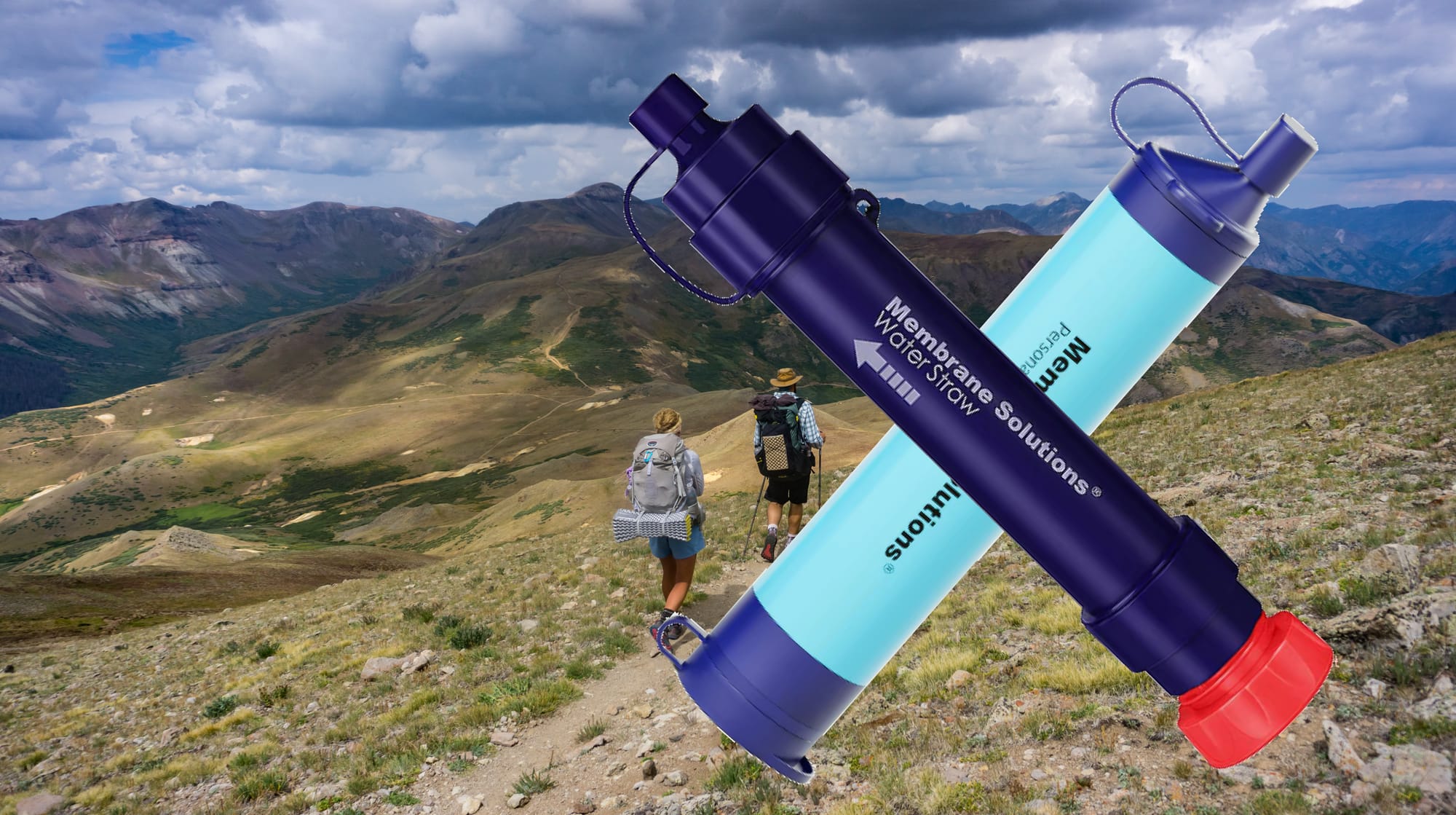
For years I was a skeptic about straw water filters for backpacking and hiking. To me, they seemed gimmicky compared to other water treatment methods that had already gained the respect of this community.
My Sawyer Squeeze already had the head nod from thousands of trekkers. And my MSR Guardian with it’s outrageous purification capabilities had me sold on first pump. And I had tried many others, mostly based on popularity in the niche. But I had not tried a straw filter.
When I looked at straw filters, which were not nearly as popular, I asked: Can a “cheap” straw filter do the job? Can it stand up to the elements and deliver confidently and consistently?
We are about to find out.
Lucky for you, SimPure approached me to do a review of their two straw filters. This was a great opportunity to investigate my bias and to answer some of the nagging questions I had.
My first happy surprise was the solid construction. These are quality built. At $39 for a set of 4, my expectations were not high. Think about being out in the backcountry with a poorly constructed filter. Our survival depends on a supply of drinking water that won’t make us sick. A filter that can’t stand up to the elements, the water pressure of a squeeze system, or a drop or two from a clumsy handler is a risk I don’t want to take. But, upon inspection, I found these filters are at least as sturdy as other trusted products I’ve used. The seals are tight and well bonded and the parts that can disassembled have precise fit. So, my first take-away was that with these filters we get great value in the construction.
The most important attribute I consider in any of my portable water treatment filters is the filtration materials and the specification and certification of those materials. I’m a bit of a nut about this, for obvious reasons. How well the filter will function to remove the bad stuff from my water is what makes it fit for purpose. Everything else matters much less.
Both of these filters are multi-stage filters. Not just two, like many backcountry filters. The light blue filter is a 5-stage. The dark blue is a 4-stage. Here is where I found a distinct advantage over many filters on the market for hikers and backpackers.
This advantage is most impactful in two of the elements: the activated carbon element and the .1 micron ultrafiltation (UF) hollow fiber membrane.
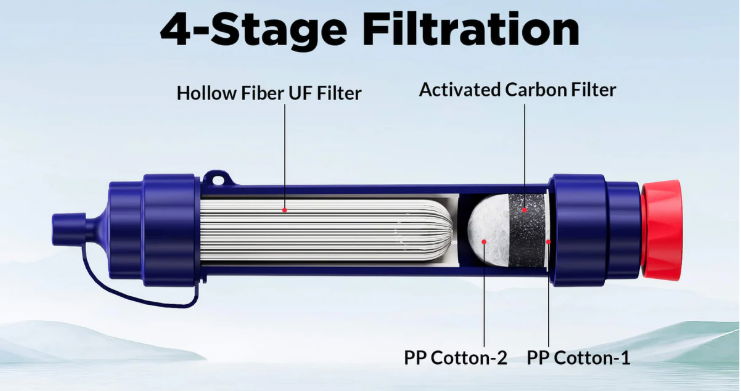
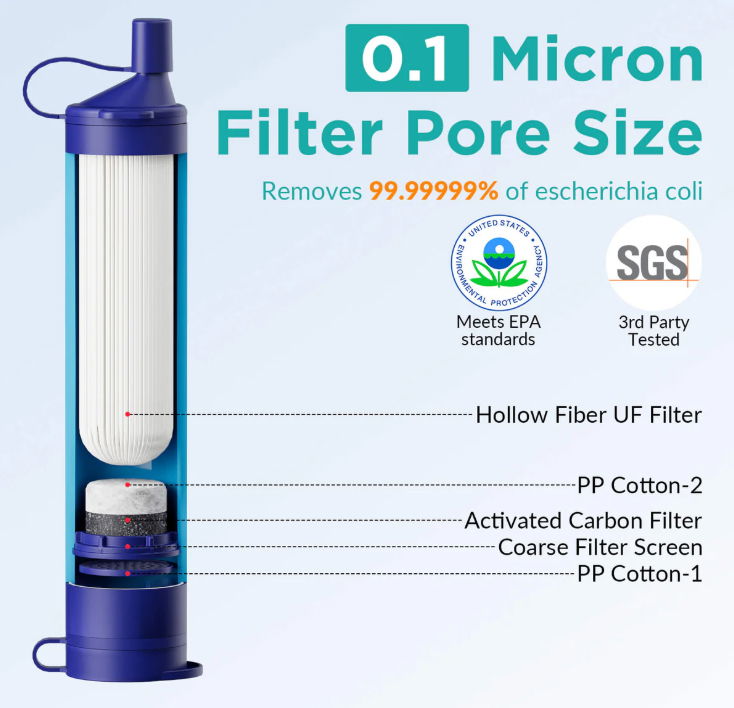
There are 3 grams of activated carbon at play here. Activated carbon reduces health hazards such as heavy metals and pollutant chemicals like what is found in pesticides, chlorine, PFCs, dioxane, and many others. It also adds essential nutrients such as calcium and magnesium. This element also reduces odors and improves taste. Admittedly, 3 grams is not a lot. But, it’s fair to say that some activated carbon is better than no activated carbon. Consider that most backcountry water filters do not have an activated carbon element.
The other standout and critical element of the multi-stage filtration method in these filters is the specification on the hollow fiber membrane. I have a video that goes into details on the construction of this membrane – be sure to check that out. The key here is that it is a “UF” rated membrane, which means it can filter out anything larger than .1 microns. Note that all dangerous backcountry bacteria is larger than .1 microns – so, by using a .1 micron filter you will not get bacteria from water at the output of this filter. I have greater detail in another article about contaminant particulate sizes – please check that out. I also have a great overview video out about all this too.
So far I’m impressed with the quality construction of the filters and with the level of filtration they provide. Really, these are the two most critical things I care about. But there are other features worth mentioning:
- They are SGS certified and meet EPA standards
- The flow rate is 500ml per minute
- The tether is convenient to help keep the filter off the ground and conveniently available.
- The caps on the ends of the filters help keep dirt and debris out of the input and output of the filter. And it keeps water that may remain in the filter from getting other items in my pack wet.
- The dark blue filter comes with a 30mm neck diameter bottle adapter for those who may not carry the standard 28mm bottle.
- It’s important to note that these filters should not be used on sea/salt water.
- Tap water can be used to filter and back wash the filters.
- The filters can be used to suck water directly from the source, in a gravity system, and using a squeeze method.
The Gravity System Kit
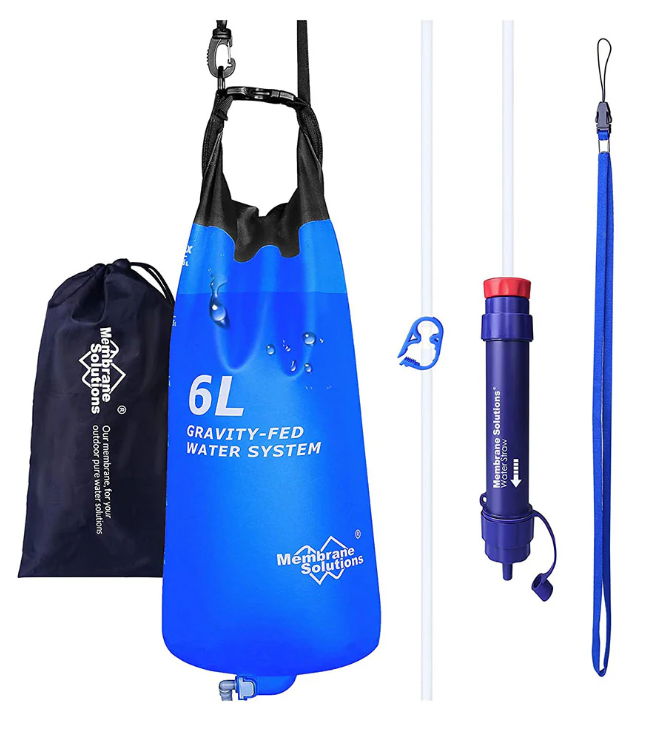
SimPure also sent me their 6-liter gravity system. Again, the quality of construction is great. The feel of the material is convincingly tough enough to handle backcountry use. A quick inspection of the bonding on the seams on the bag shows attention to their commitment to quality and durability. I’ve had other bags from other manufacturers that were not nearly as well built as this one is.
Note also the built-in hanging strap and associated hardware make this a complete, field-ready unit.
The 3-foot long food-grade hose comes with a quick connect device on one end that makes connecting and disconnecting to the bag quick and easy. And it’s plenty long enough for any common use scenario. For instance, if you have a branch above your head – this will accommodate.
And there is a valve on the hose to temporarily stop the water flow when needed. For instance, when changing out bottles on the filtered end.
They have instructions for use and care on one side of the bag and measurements in liters and gallons on the other side. The translucency of the bag allows you to easily see how much water is in the bag at any time.
The kit comes with a very light weight carrying and storage bag. No more parts scattered around camp or in your gear closet.
The Collapsible Water Container Bottle Pouch
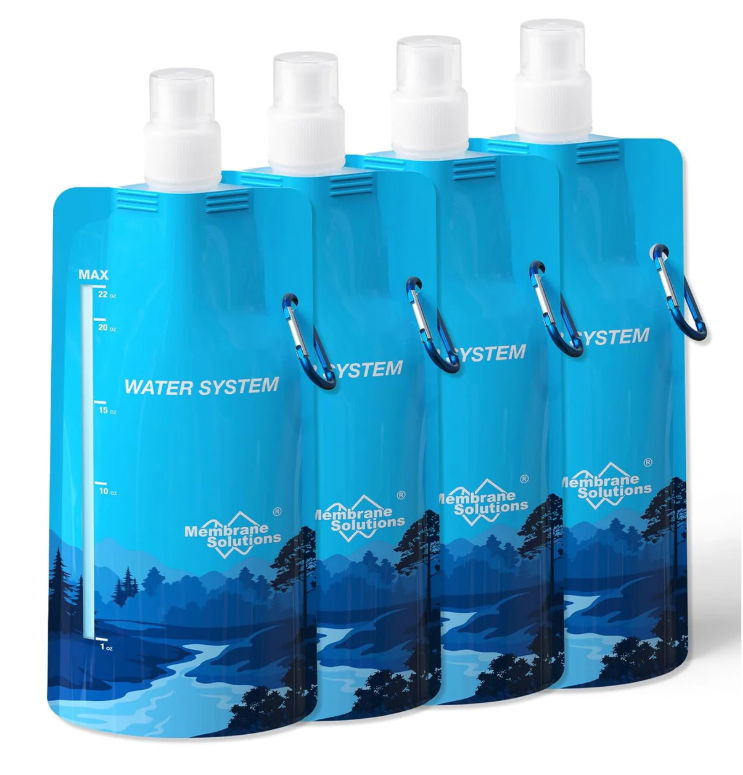
These bottle pouches come with the squeezable kit or they can be purchased separately. Again, on first inspection, the quality of construction is convincing. These have the standard 28mm neck diameter so they can be used for either your “dirty” water to squeeze into the filter or they can be used to receive filtered water on the other end of the filter. If you are using these for dirty water, it would be wise to mark the bottle somehow to be sure you aren't mixing dirty and clean containers.
The pouch capacity is 23oz and is made of food grade BPA Free material.
It is collapsible to better fit into backpacks and it weighs about an ounce.
It also comes with an attached carabiner which allows for easy attachment to packs or anyplace that may make it convenient for access or storage off the ground.
There is a cap to protect the pull spout. This combination offers a cleaner drinking end and stronger leak-proof experience.
Trail Test
No gear review is complete without a good test on the trail. For these water filters I wanted to test all the different scenarios with both filters and gravity bag over a multi-day period.
I used water from relatively clear sources and from some pretty nasty ponds (worse than what I or the manufacturer recommends).
I was also with a friend who was using a common, similar but different brand filter. That was nice for comparison.
The flow rates tested true to what was advertised - 500ml per minute.
I also tried the gravity system and the squeeze method. Both worked flawlessly and to expectation.
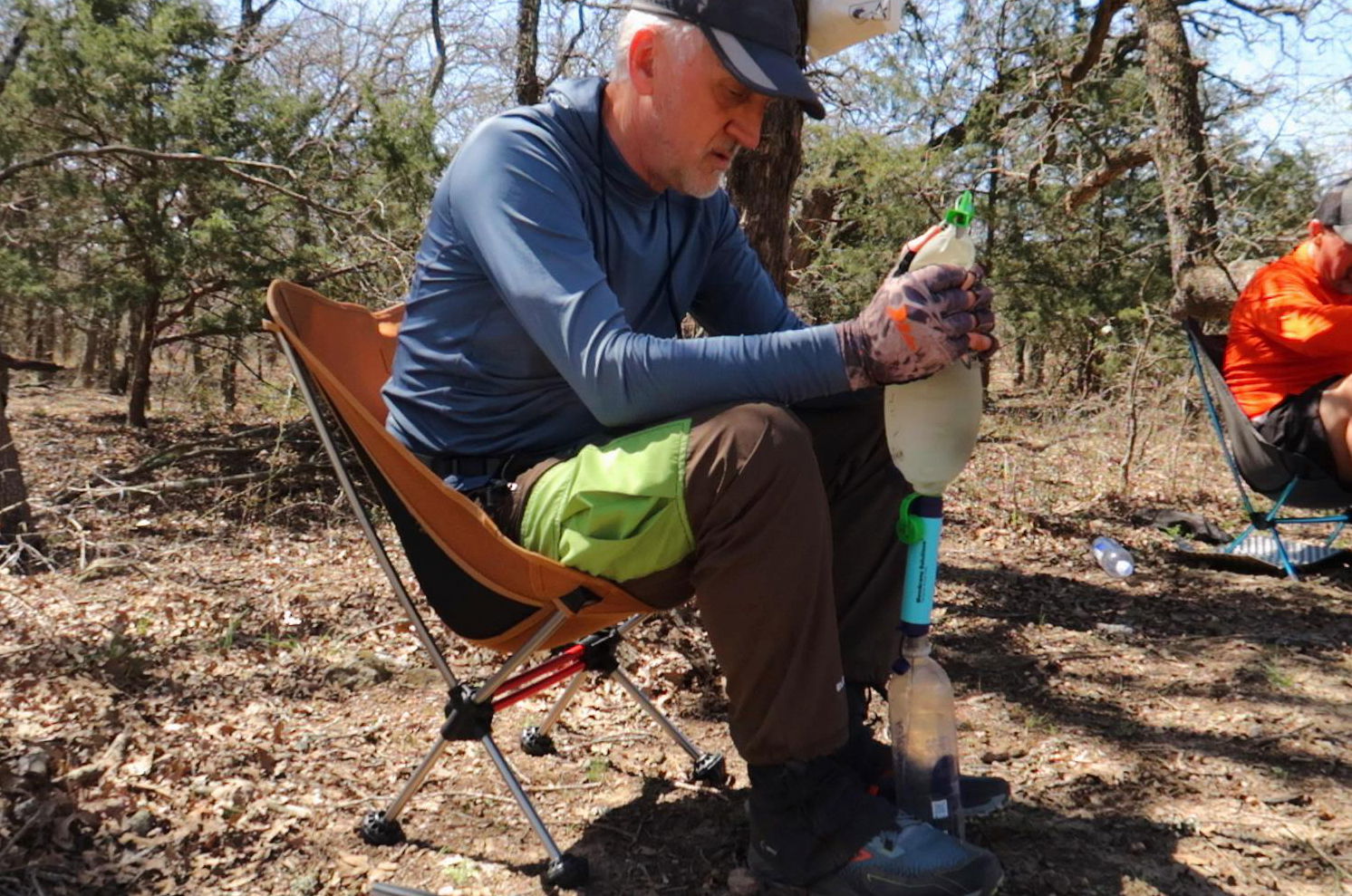
Filtering water using the squeeze method
Backwashing
My hiking partner and I were taking water and filtering from the same sources throughout the multi-day adventure, and it turned out that his filter needed back washing as often as the Membrane Solution filters did. And so, the Membrane Solutions filters were clogging or slowing down at about the same capacity and time frame as other popular filters. It was no better or worse. This was expected as both types of filters use similar membranes.
When water was taken from clear sources, my filters processed 7 liters before showing signs of a slower flow rate. When water was taken from very murky sources, the filters showed signs of a slower flow rate after only 2 filtered liters. Of course, the variables here are numerous, which will impact the number of liters before the flow rate begins to slow.
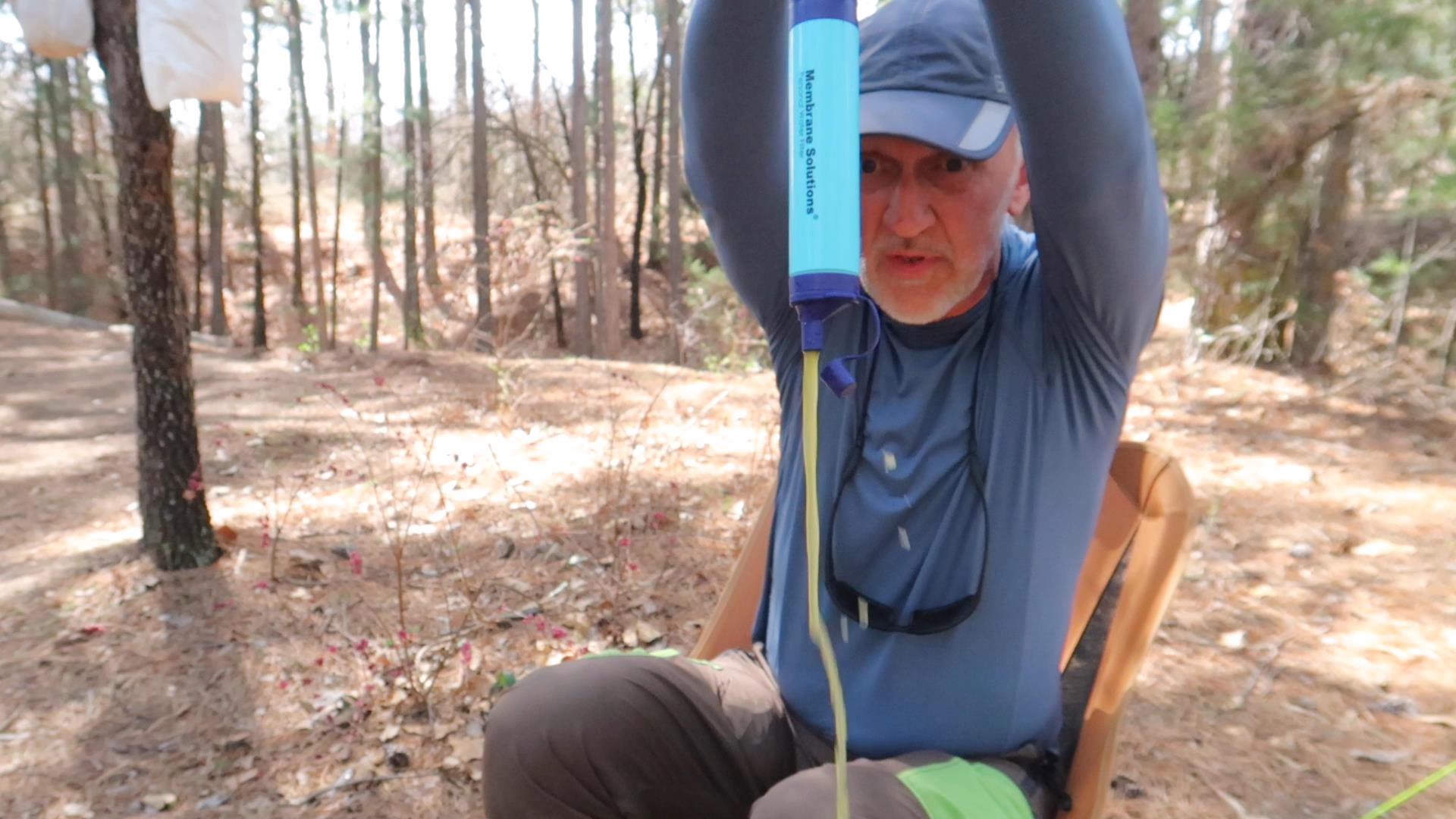
Backwashing the filter.
For the Light Blue filter, I used an alternate but manufacturer recognized back washing method, as demonstrated in this video. The result was as expected: the filter flow rate returned to normal after properly back washing.
It's important to note that using enough water to back wash can extend the life of the filter. Too many times I've seen hikers use only a fraction of a liter to back wash. A good backwash should be about a liter of water - more if needed.
Also, one tip that I didn't find in the manufacturer's recommendations is to lightly tap the filter (on a piece of wood or something that won't damage the filter housing) between back wash "squeezes". Depending on how dirty the filter is, you may notice discoloration in the extracted water after you tap and squeeze again. But, again, be very careful not to damage the filter housing. If you damage the housing you may render the filter ineffective.
Results
This is obviously not a long term review. But, after a multi-day backpacking trip, I feel I have enough experience with these filters to make at least a preliminary observation and recommendation.
These Membrane Solutions filters performed as advertised. They performed as well as other similar and commonly used portable water filters.
A few noteworthy and positive items:
- The Dark Blue filter elements can be purchased separately and easily replaced in the field. This helps reduce waste and, in that the replacement elements are very light weight, it makes for a very nice backup option when on longer backpacking trips.
- The end caps don’t sound like a big deal, but when in muddy or especially dirty places, having those end caps is a tremendous help with gear maintenance. And it takes away one of many small concerns when considering how gear is stored in my pack (much less water leakage).
- The tether is very convenient for storage and carry, keeping the filter off the ground and cleaner.
- The price is amazing; it’s a great value.
Suggested Improvements
- These filters do not come with adapters to make them useful as an in-line bladder filter. This isn’t a deal-breaker, but it would be a nice additional offering.
- The Light Blue filter does not have a flow direction arrow. This also isn’t a big deal, but if ever someone disassembled the unit, it would be a nice safety measure to ensure the ends were put back on correctly.
Maybe the most important outcome of this review for me is that Membrane Solutions has changed my mind about whether straw water filters could meet my expectations for use in the backcountry. Indeed, I think this one might; I’ll need more time with it, but it’s been very positive so far.
I will continue to use and test these filters over the coming months. At some point, if I have no major issues or concerns I would consider this as my primary water treatment system for my backpacking trips.
Links for Purchasing - Help Support this Website
To purchase these products, please help support this website by using these affiliate links (at no additional cost to you):
- All outdoor water filters from SimPure (Membrane Solutions) – this includes gravity kits
- Light Blue Filter on Amazon
- Dark Blue Filter on Amazon
- Squeeze filter kit on Amazon
- Replacement kit for dark blue filter on Amazon